|
29th October
Skinflats
Skinflats
is an RSPB reserve that is still very much under development. It is mainly
saline lagoons and saltmarsh environment and a haven for thousands of wintering
waders and wildfowl. We hoped to see some of these as we parked in plain view
of the impressive Kelpies at the other side of the M9 motorway. The site can
be very muddy so we changed into wellies and plodded down a long, straight and
rough road towards the salt pools. Almost immediately we came upon three
Stonechats cavorting in the bushes. As they paused to check us out I took a few
shots. The light was perfect and I managed nice shots of the bold male and his
more cautious female. Soon after, a Kestrel turned up and started to hover over
a stubble field – only to notice us and speeding off well out of range.
Kelpies
|
Male Stonechat
|
Female Stonechat
|
Kestrel
|
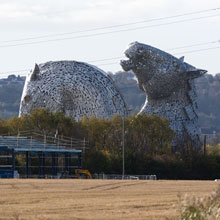
|
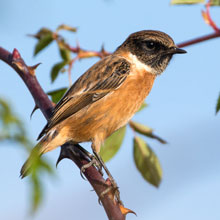
|
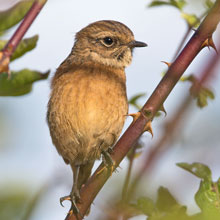
|
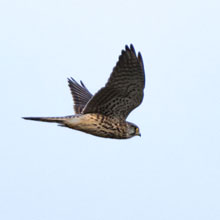
|
Still not 100m from the car, we were attracted to a sun-bathed patch of Ivy
which was host to swarms of insects. They were mainly hoverflies – Eristalis
Arbustorum and Helophilus Pendulus (“The Footballer”’ - its the stripes!), but
we also caught pictures of the bluebottle, Calliphora Vicina and the Yellow
Dung Fly, very common where there are cattle.
| Hoverfly - Eristalis arbustorum |
Hoverfly - Helophilus pendulus |
Fly - Calliphora vicina |
Yellow Dung Fly
|
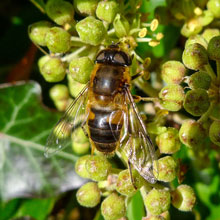
|
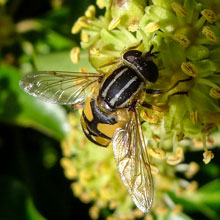
|
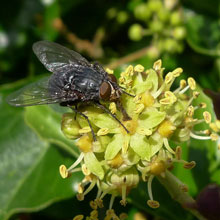
|
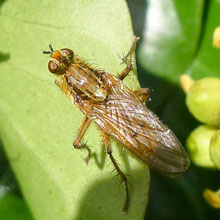
|
As we explored a wooded area adjacent to the path for Redwing, we discovered
what at some time must have been a small orchard of apple trees. The trees were
absolutely full of large, ripe, sweet apples. Only a calling Yellowhammer drew
us away out of the orchard. A handsome Buzzard emerged from another small wood
and circled over the same field the Kestrel had surveyed earlier. We eventually
reached the pools where we found a dozen or so Canada Geese at the far side.
Apple Tree
|
Yellowhammer
|
Common Buzzard
|
Canada Goose
|
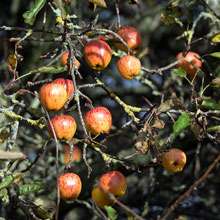
|
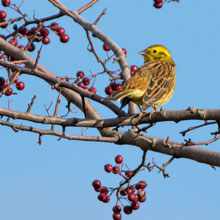
|
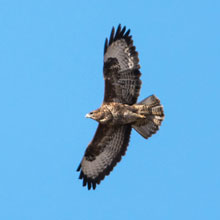
|
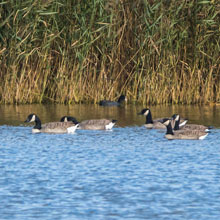 |
We made our way around the pool towards the sea wall, or bank. In the trees
that lined the path a Goldcrest was nipping from branch to branch barely
pausing long enough for a me to catch a shot. Eventually I was successful and
we were able to move onto a small field where we found a lonely Stubble
Rosegill mushroom near a patch of Common Ragwort. At last we scrambled up the
very muddy bank and scanned the very impressive River Forth panorama, dominated
by the Longannet power station across the Estuary. The tide was low and there
were lots of waders, mainly Shelduck (regrettably too distant for a picture).
Goldcrest
|
Stubble Rosegill
|
Common Ragwort
|
Longannet Power Station
|
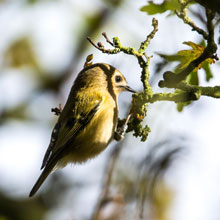
|
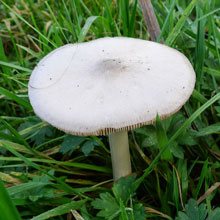
|
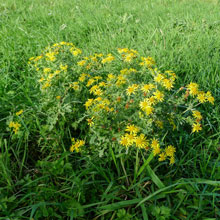
|
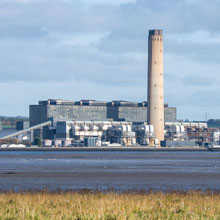
|
As we returned back around the pool, a beautiful Whooper Swan glided across
our view, while at the far side a group of Mute Swans were nervously preening.
John spotted a pair of Roe Deer running across a field. They seemed to be
running away from some threat or other although they hadn’t noticed us before
they disappeared through a hedge into another field. Next we headed east along
a very mucky, cow-trodden path past the second pool. Only a pair of Curlew were
there but even further east I snapped a Kestrel sitting on a fence post.
Perhaps it was the same bird we’d seen earlier.
Whooper Swan
|
Mute Swan
|
Female Roe Deer
|
Common Buzzard
|
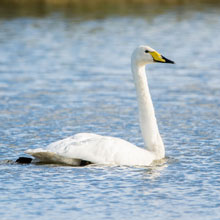
|
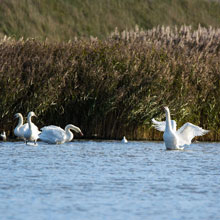
|
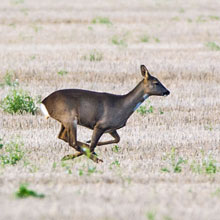
|
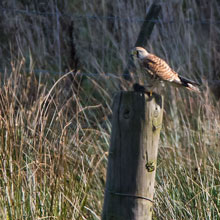
|
As we reached the single track road that runs parallel to the River Carron
we heard the sound of hundreds of geese, probably Pink-foots, taking flight far
to the west. The odd group passed close enough for reasonable shots. As we sat
admiring that genuinely awesome sight and sound, Yellowhammers flew into a bush
close to where we were sitting. As I stalked them, a Redwing darted from the
same bush.
Back at the car our tea tasted great but we were slightly disappointed with
our Danish pastries which were slightly undercooked. John had bought them after
our very enjoyable Grangemouth Tesco’s breakfast (9/10). But it had been a very
satisfying visit to a very impressive reserve. I do hope the RSPB don’t
overdevelop it.
Pictures of the week:
Male Stonechat
|
Female Stonechat
|
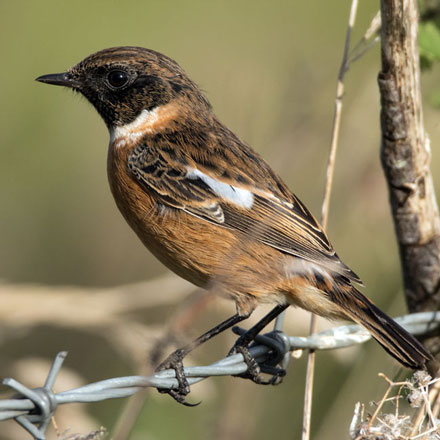
|
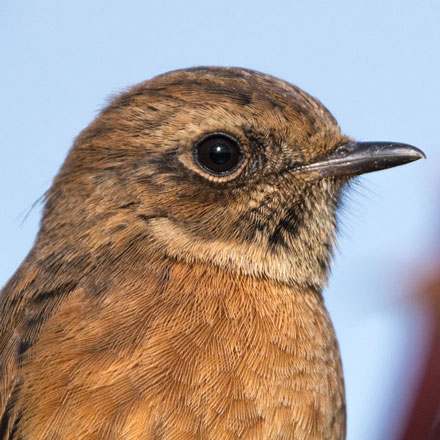
|
| Hoverfly - Helophilus pendulus |
Pink - footed Goose
|
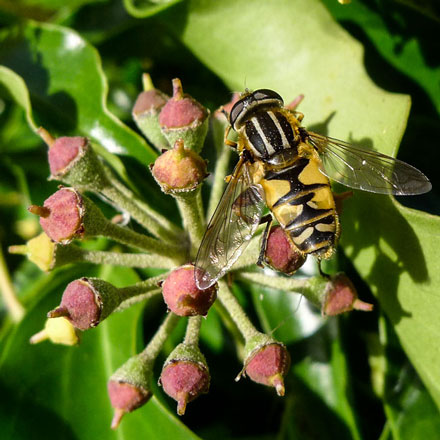
|
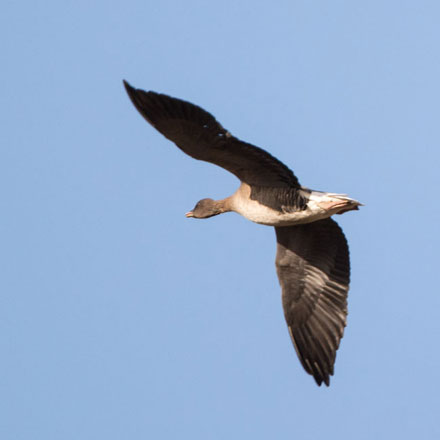
|
22nd October 2017
Whitesands and Barns Ness
We were drawn to Whitesands
Quarry, near Dunbar, by the promise of seeing the Bar-headed and Todd’s
Canada Geese that had been reported there in the previous few days. The
weather was disappointing as it was very dull with periodic bouts of
drizzle. However we were optimistic that we might get a little sunshine
at some point in the afternoon. When we arrived we were faced with a
more basic problem – most of the birds were at the distant far end of
the man-made loch in the former quarry. We moved to that end, via a
cycle path we hadn’t known about until a fellow photographer pointed it
out. Our first capture of the day was
of a Yellowhammer sitting on a bush at the side of the cycle path. It
was probably tempted out of hiding by the arrival of the sun. We were
still about 150m from the birds, but a least the strong sunlight was
behind us. There were large flocks comprising Great Black-backed Gulls,
Greylags and Herring Gulls.
Yellowhammer
|
Great Black - backed Gull
|
Greylag Goose
|
Herring Gull
|
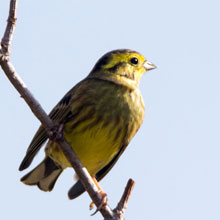
|
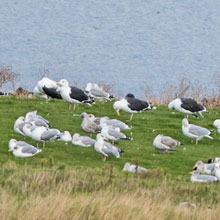
|
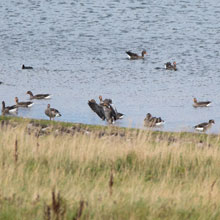
|
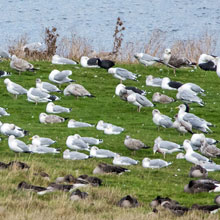
|
Below us, in the long grass, a
domestic horse was grazing. It had a coat on but it was probably
sweltering in the sunshine. As I was snapping the distant Canada Geese,
trying to determine whether any of those were of the Todd’s variety, a
huge flock of Pink-footed Geese took to the sky. They had been out of
sight on the slopes between us and the water – so I’m glad they took
off or we’d never have known they were there! As for the Todd’s Canada
Geese and the Bar-headed Geese, we didn’t see them. Oh well, never mind!
We returned to the hide at the
other end of the Loch to check the groups of Ducks we’d spotted. There
were Pochards, male and female, lots of Tufted Ducks and of course
Mallards. The lovely light had gone and the drizzle returned to annoy
us. John drew my attention to a wee flock of Wigeon flying in from the
sea. They settled at the far side of the Loch.
Pochard
|
Female Tufted Duck
|
Mallard
|
Wigeon
|
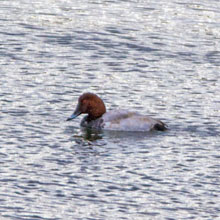
|
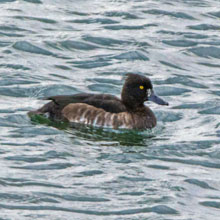
|
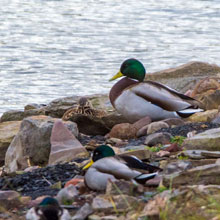
|
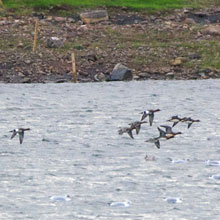
|
Just as we left the hide, John saw
a pair of Goldeneye diving about 100m away. Even in the gloom their
golden eyes stood out. Not far from the Goldeneyes a smaller brown duck
was diving. This turned out to be a female Long-tailed Duck. We made a
brief stop to check out the beach for any birds. Only a pair of Carrion
Crows caught my attention as they tried to smash shellfish by dropping
them from the air onto rocks. As we drove further east towards Barns
Ness I had to stop the car a couple of times to take pictures of birds.
First spot by John was a female Kestrel. He took the pictures once I’d
safely parked and turned off the engine.
Goldeneye
|
Female Long - tailed Duck
|
Carrion Crow
|
Female Kestrel
|
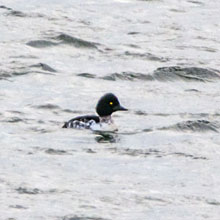
|
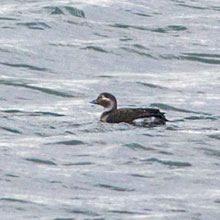
|
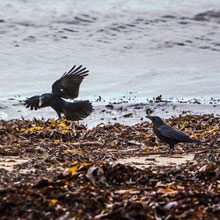
|
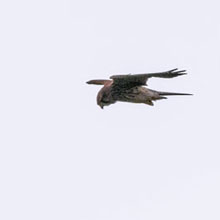
|
Next spot and picture en route was
again by John – a female Pheasant that thought it was invisible if it
stood perfectly still. After parking at the Barns Ness car park we
walked around the Wire Dump. John pointed out a large rock offshore
occupied by a Herring Gull and a female Goosander, but the bushes were
very quiet maybe due to the low light levels. But as we entered the old
caravan park John’s eye (yes he certainly had his spotting eye in for
this trip!) glimpsed a female Kestrel streaking above the bushes. I
managed a couple of shots even although it was darting about for only a
brief moment. We then arrived back at the car for tea and delightful
danish pastries filled with cream and apple. We headed home fairly
satisfied – but we had a final surprise. We came across the female
Kestrel resting in a tree by the exit. Lovely.
Female Pheasant
|
Female Goosander
|
Kestrel...
|
Kestrel
|
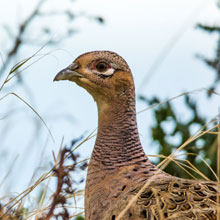
|
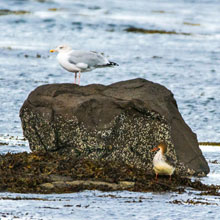
|
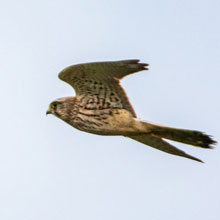
|
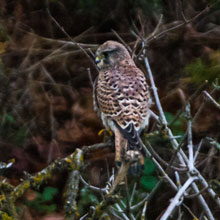
|
Pictures of the week:
Yellowhammer
|
Female Pheasant
|
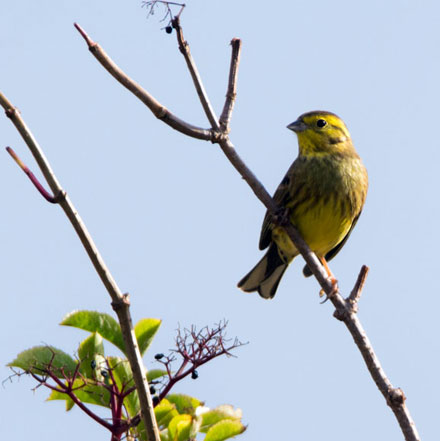
|
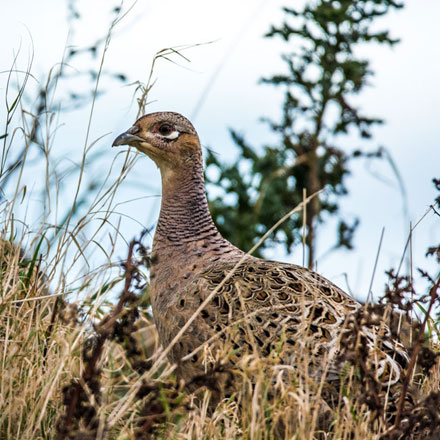
|
15th October 2017
Skateraw and Belhaven Bay
With the west of Scotland under a
depressing grey cloud we headed for the sunny east. Skateraw was
steeped in sunshine and although the wind was fairly strong it wasn’t
cold. So it was great condition for a wee stroll around the bay. And it
wasn’t long before I was snapping away. My first target was a small
flock of Starlings, mainly juveniles. As we made for the rocky Point
where we had observed a congregation of birds, a pair of Rock Pipits
seemed to track us. As we sat by the rocky shore, first a Cormorant,
then a Curlew flew in to swell the numbers.
Starling
|
Rock Pipit
|
Cormorant
|
Curlew
|
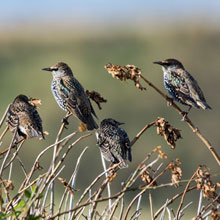
|
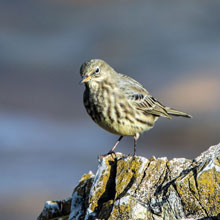
|
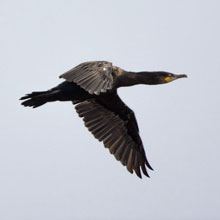
|
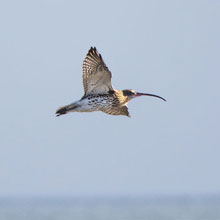
|
I slowly and
carefully sneaked a bit closer to the birds and sat on my 3-legged
stool (I have found that birds are not as liable to fly off if I’m
sitting). The wind was whipping up the sea, creating big waves that
broke onto the rocks throwing up exciting packets of spray. A Cormorant
sat just beyond the spray making a nice photographic subject. A large
group of gulls – mainly Great Black Backed juveniles and Herring Gulls,
were huddled down facing into the wind. Similarly, a half dozen or so
Bar-tailed Godwits were grouped low and close together and all but one
had their beaks under their wings.
Cormorant
|
2nd Cycle Great - black Backed Gull
|
Herring Gull
|
Bar - tailed Godwit
|
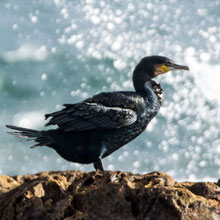 |
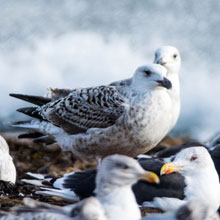 |
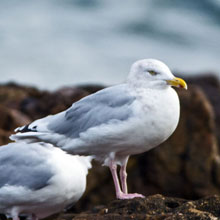 |
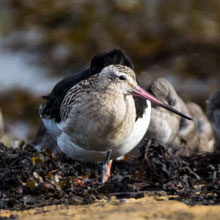 |
I retreated to the grassy bank,
passing a lone Turnstone perched on a rock. It was obviously
unconcerned by the wind and waves. The Rock Pipits were still checking
us out as we made our way back to the car park. We unconsciously
disturbed a Curlew that had been sheltering between the large rocks on
the shore. Offshore a female Eider was picking off a crab’s legs before
downing the whole shell.
Turnstone
|
Rock Pipit
|
Curlew
|
Eider
|
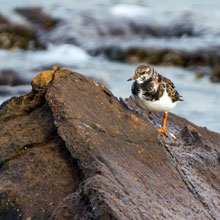
|
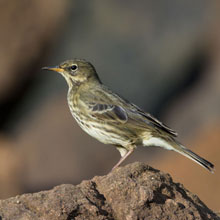
|
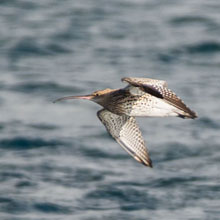
|
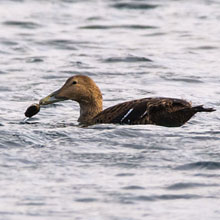
|
We moved west to the rather more
calm Belhaven Bay. The tide was on its way out and the inner Bay was
filled with a variety of species. I spotted some Wigeon dabbling in the
shallows and through his binoculars John spied a pair of Pink-footed
Geese. The geese seemed a bit out of place there. It was more usual to
see them in a large flock on a hillside. We walked by the seawall
watching the ever-present Oystercatchers and Redshanks going about
their business.
Wigeon
|
Pink - footed Goose
|
Oystercatcher
|
Redshank
|
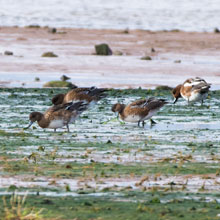
|
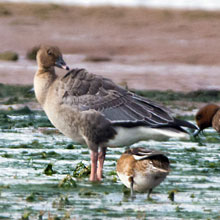
|
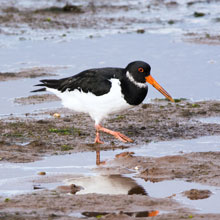
|
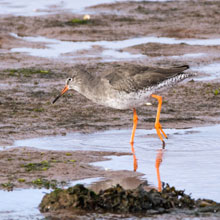
|
At the Seafield Pond there were
other ever-presents - a family of Mute Swans, always photogenic. The 4
cygnets were almost fully grown but were still following their parents
as if connected by invisible tow lines.
Other familiar birds at the Pond
were Mallards, Little Grebe and Teal. The Mallards, like the Swans,
were inquisitive to find out if we had any goodies for them – no chance
as John and I rarely feed the birds we observe. John remarked that the
Teal looked unfamiliar. This was probably due to their current eclipse
phase plumage and maybe its small size – Teal are the UK’s smallest
duck.
Drake Mallard
|
Juvenile Mallard
|
Little Grebe
|
Female Teal in Eclipse plumage
|
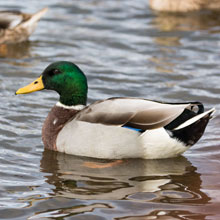
|
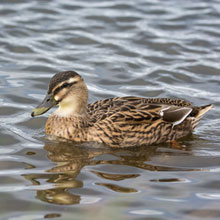
|
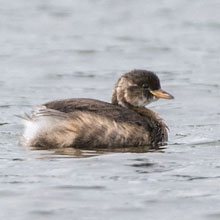
|
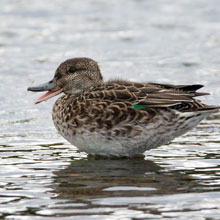
|
We returned to the car fairly
satisfied with the day’s collection of pictures, although we hadn’t had
any unexpected sightings, other than perhaps the Pink Foots. It had
been a very pleasant trip, and to round it off, with our tea, John and
I consumed fruit scones with cream and jam. At our ages – naughty, but
nice!
Pictures of the week:
Cormorant
|
Rock Pipit
|
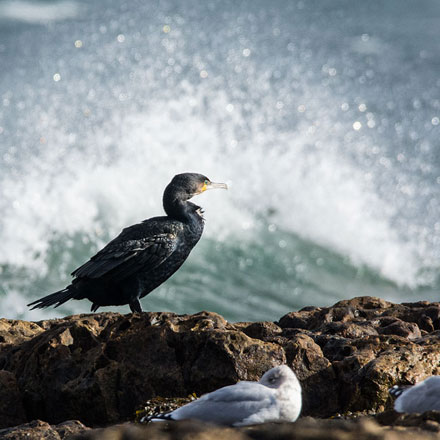
|
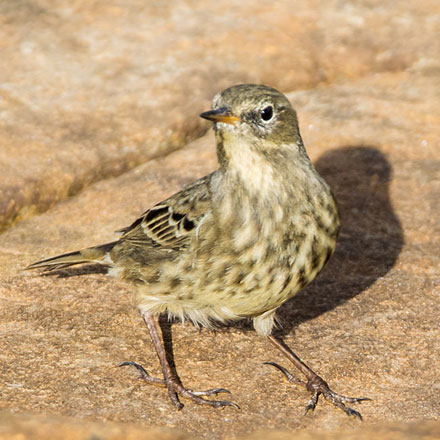
|
Juvenile Eider
|
Oystercatcher
|
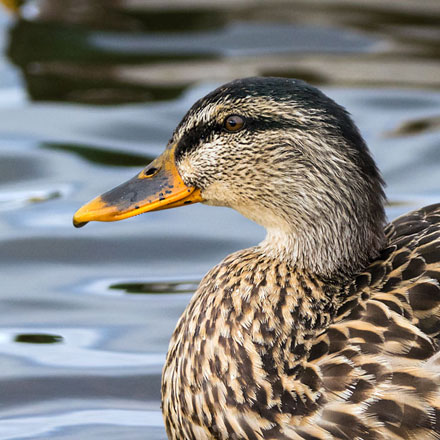
|
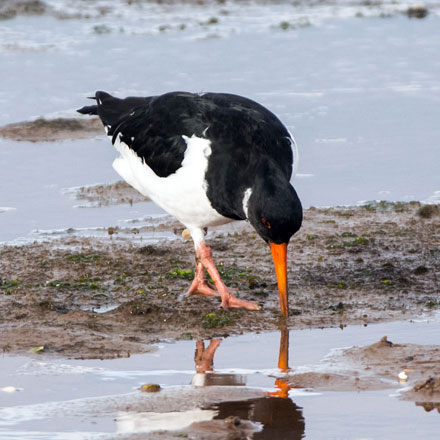
|
8th October 2017
Musselburgh
It was cloudy as we drove east to
Dalkeith Morrisons for our Sunday breakfast before heading for
Musselburgh. I told John that cloud was predicted to clear by the time
we’d leave the cafe. As it turned out, that was just a bit later than
anticipated as the service was very slow. However we did leave well
satisfied with the meal (8/10), and also satisfied with the weather –
clear blue sky! We belted round to the mouth of the River Esk eager to
get our walk underway in the fine morning light.
Our
first sighting was a lone female Goldeneye diving in the Esk. On the
far bank a Black-headed Gull was consuming a small flat fish. It took
some time to figure out how it was going to get it down. John then
directed me towards a Speckled Wood butterfly resting obligingly on a
blade of grass. Next, several Mute Swans flew up the river from the
shoreline. They made an impressive sight in the strong sunlight backed
with the blue of the sky and sea.
Goldeneye
|
Black - headed Gull
|
Speckled Wood Butterfly
|
Mute Swan
|
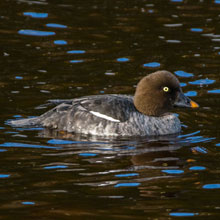
|
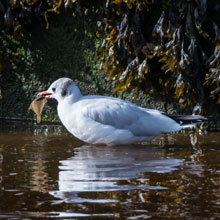
|
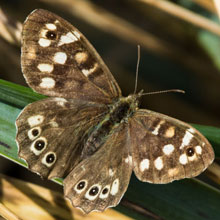
|
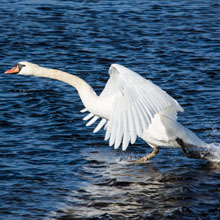
|
As we tracked round the seawall making for the Scrapes we met the expected
birds – the ever-probing Redshank, the solitary Curlew with an unlucky Shore
Crab and the ubiquitous, underrated Mallard. We also saw a small flock of
Wigeon. They were in shabby-looking eclipse plumage but it was nice to see them
as they soaked up the sunshine on the shore.
Redshank
|
Curlew
|
Drake Mallard
|
Wigeon
|
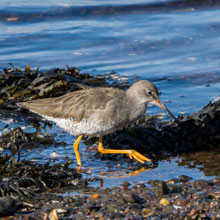
|
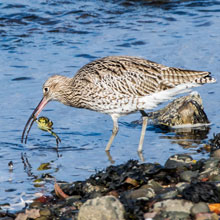
|
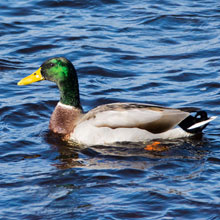
|
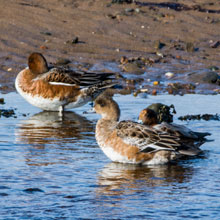
|
Our viewing enjoyment was abruptly
interrupted by a pair of barking beagles accompanied by their
inconsiderate owners. All the birds fled and we plodded east before I
yielded to the temptation of shouting abuse. We did see another Curlew
at the far edge of the beach. It seemed less than concerned with the
commotion. As we reached the seawall just by the Scrapes a large flock
of about 40 Greylags passed noisily overhead. In amongst them was a
leucistic individual, or perhaps it could have been a hybrid.
In the sea we saw more familiar
birds- a young Sandwich Tern catching a fish, a passing Cormorant, a
male Eider and a female Goosander.
Sandwich Tern
|
Cormorant
|
Eider
|
Female Goosander
|
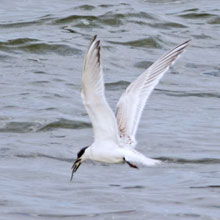
|
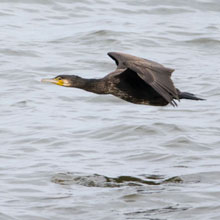
|
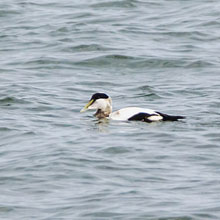
|
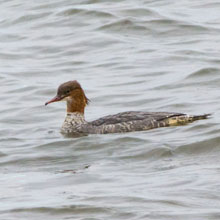
|
In the time it had taken to walk
to the Scrapes, the blue skies and sun had disappeared, replaced by
ever-deepening grey clouds. As we entered the Scrapes I recalled my
previous visit there 2 days before when I had witnessed a Peregrine
taking a Ruff. It circled over the Scrape several times picking out
it's likely prey then it swooped dramatically and in a splash carried
off its poor victim to meet it's fate.
On entering the far right hand hide I immediately saw a Ruff foraging very close in. Behind it an eclipse Teal was
lurking. A Grey heron flew in from the east and landed a the back of
the Scrapes. In the short grass below the hide a Wood Pigeon seemed to
be wondering if it should fly away from the noisy creatures in the hide
that were pointing clicking machines at it. Eventually it did.
Ruff
|
Teal in Eclipse plumage
|
Grey Heron
|
Wood Pigeon
|
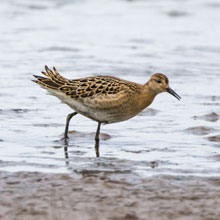
|
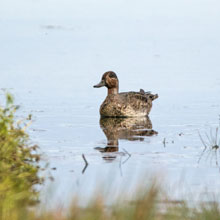
|
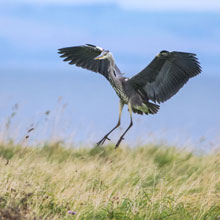
|
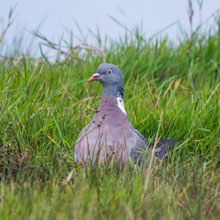
|
Not
so a Magpie that was beside the pigeon. It boldly strode closer daring
us to bring it on. Eventually we moved to the leftmost hide. The light
had deteriorated badly and it was hard to make out plumage markings.
There was no mistaking the Spotted Redshank though. It had a
distinctive silhouette with longer pointed beak than the Common
Redshank. On the same Scrape another Grey Heron emerged from the reeds
cautiously stalking the shallow edges of the pool. Beside it a Teal was
unimpressed as it dabbled the same stretch.
Magpie
|
Spotted Redshank
|
Grey Heron
|
Teal in Eclipse plumage
|
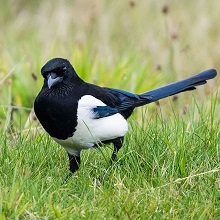
|
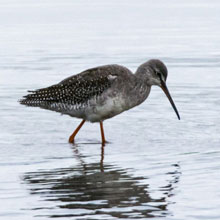
|
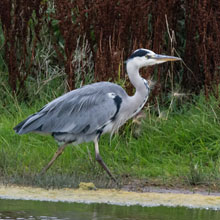
|
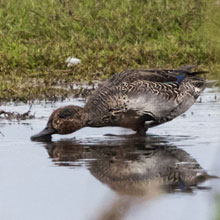
|
With the light poorer than dull we
set off back to the car returning along the same route. About 100m
offshore two pairs of winter plumage Slavonian Grebes and Great Crested
Grebes were diving. As we walked we were met by wave after wave of
Oystercatchers and Curlew returning from the incoming tide on the
shores to the shelter of the Scrapes.
Slavonian Grebe
|
Great Crested Grebe
|
Oystercatcher
|
Curlew
|
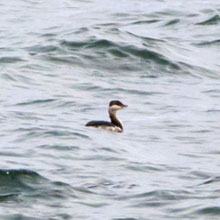
|
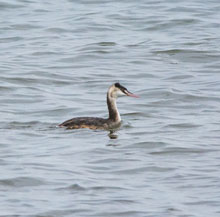
|
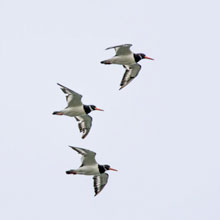
|
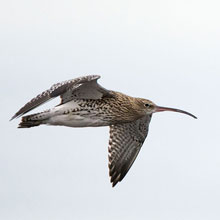
|
Several “squadrons” of Bar-tailed
Godwits were amongst these birds. Meantime on the sea a Cormorant
didn’t seem to be at concerned with the tides as it made dive after
dive into the gloomy sea, only occasionally surfacing with fish. Much
further out Velvet Scoter had appeared. I often wish they would sneak
inshore for just one quick photo! Maybe one day. My final picture was
of a solitary Twite. It wasn’t close and the light was dreadful, but
there was no mistaking its posture and tell tale yellow beak.
Bar - tailed Godwit
|
Cormorant
|
Velvet Scoter
|
Twite
|
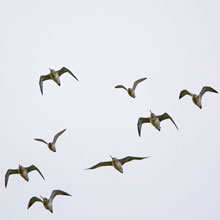
|
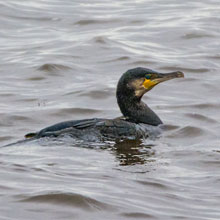
|
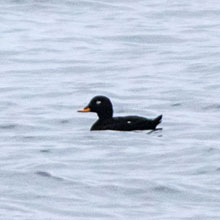
|
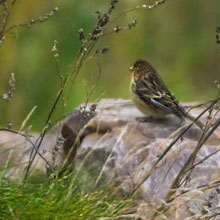
|
At the car our warm teas and
Danish Pastries were very welcome in the stiffening breeze. We
discussed our great haul of pictures and also how much of a nuisance
irresponsible dog walkers are. And to cap off a super day, the traffic
was very light on our way home.
Pictures of the week:
Greylag
|
Grey Heron
|
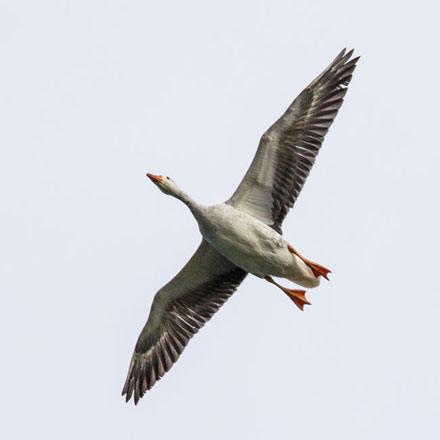
|
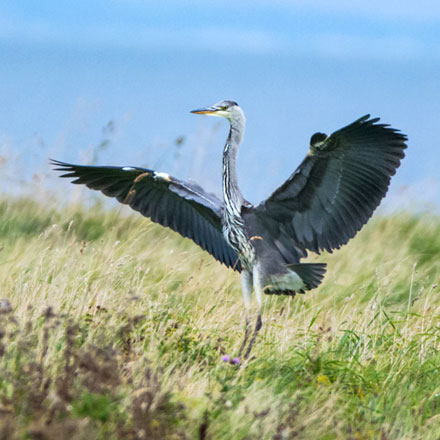
|
Ruff
|
Curlew
|
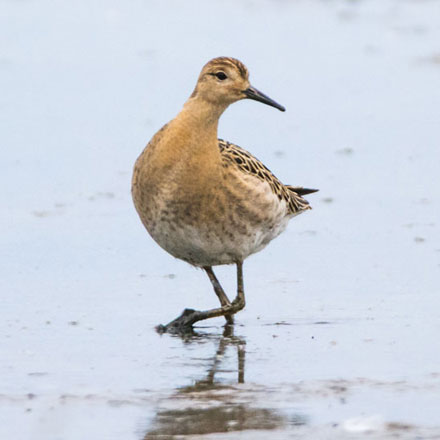
|
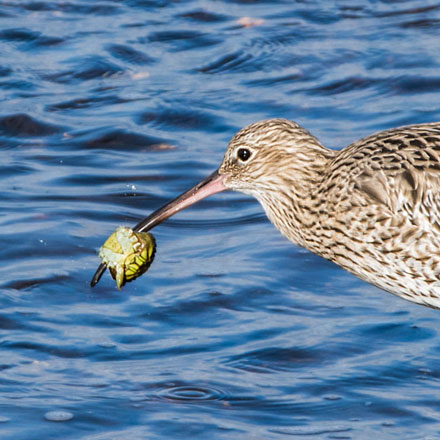
|
1st October 2017
Stevenston Point, Saltcoats
The weather prediction was, well, abysmal. Coast-to-coast rain, high winds,
no sunshine – not exactly conditions conducive to achieving fine photographs of
nature. However we accepted the challenge and, if nothing else, we would get a hearty
breakfast in Stevenston Morrisons, one of our favourite and most reliable
cafes. Stevenston Point was our first
stop. To our surprise there was a lot to see, albeit through persistent
driving rain. I got a nice shot of a Cormorant during a rare, brief,
dry episode but soon we realised that I could take shots out of my open
car window as the wind was battering John’s side of the car. He became
the “spotter” and I captured images of the birds as they passed. There
were frequent passes of Gannets and the odd sets of Eider. I captured a
lovely shot of a lone Mediterranean Gull (see Photos of the Week below).
Cormorant
|
Gannet
|
Eider
|
Gannet
|
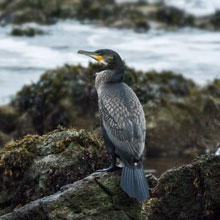
|
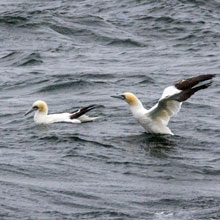
|
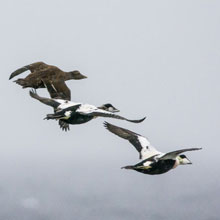
|
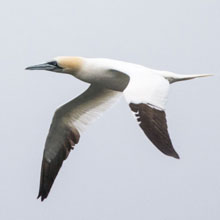
|
I caught a 1st cycle Herring Gull
with a fish in its beak as it frantically tried to evade other Gulls
that were trying to steal its dinner. Eventually it dropped it and they
all got nothing (there’s a moral there!). A striking 1st cycle Great
Black-backed Gull hovered into the gale allowing me to get most of it
on record. Offshore a Common Guillemot bobbed up and down looking very
small and vulnerable but I dare say it was in its element. Not far from
it was a juvenile Razorbill riding the waves with consummate ease.
1st Cycle Herring Gull
|
1st cycle Great Black - backed Gull
|
Common Guillemot
|
Juvenile Razorbill
|
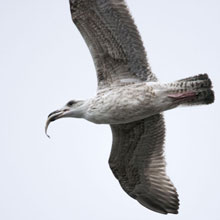
|
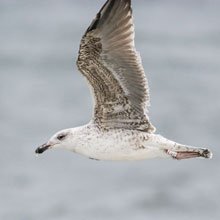
|
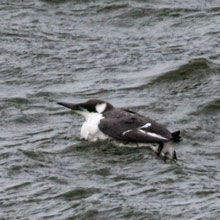
|
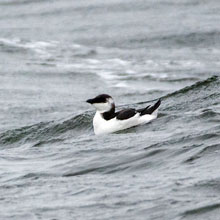
|
Very active around the Point were
Sandwich Terns, their familiar creaky calls giving the first sign that
they were passing. We watched them for half an hour then suddenly it
appeared there had been an invasion of Gannets. Where they came from
was a mystery at the time but thinking back I reasoned that they must
have been on the surface of the sea and on seeing a few passing Gannets
diving successfully, they had taken to the air to join in. Like the
Gannets, the Terns dived dramatically into the rough sea, only
occasionally surfacing with the prize of fish. After an hour or so of
watching the Gannets we tired of hiding from the weather and decided to
check out Saltcoats Harbour to see if any waders were sheltering there.
As we drove off the Point we came across patches of Starlings probing
the grassy areas for worms. A smart Black-headed Gull was amongst them,
treading the grass, simulating raindrops to fool the worms into coming
to the surface – a bit unnecessary given the weather!
Sandwich Tern
|
Gannet
|
Starling
|
Black - headed Gull
|
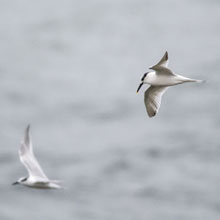
|
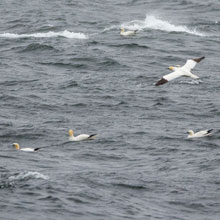
|
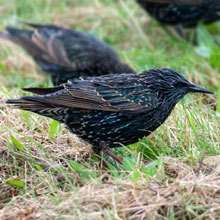
|
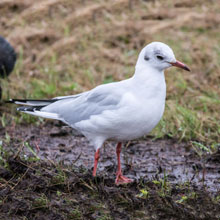
|
In a playing field a few Great
Black-backed Gulls were also hunting for worms. These included a 2nd cycle individual, its adult plumage almost complete. At Saltcoats Harbour conditions
improved slightly. It wasn’t as dull and the rain had stopped. It was
still very windy though, not that it bothered the numerous Gannets that
passed by the small tower at the end of the Harbour. We observed from
there for an hour and were pleasantly surprised how sheltered we were
there. The passing birds got very close as they flew low around the
Harbour walls, sheltering from the winds.
| Great Black - backed Gull... |
...2nd Cycle
|
Gannet...
|
|
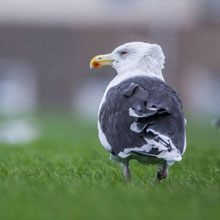
|
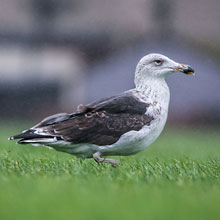
|
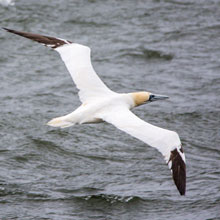
|
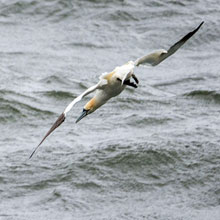
|
Eider, Sandwich Terns and Common
Guillemot came within camera range, but further out John spotted a
flock of Common Scoters diving in the heaving surf.
Eider
|
Sandwich Tern
|
Common Guillemot
|
Common Scoter
|
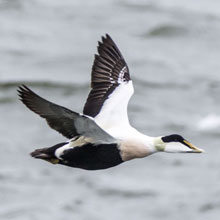
|
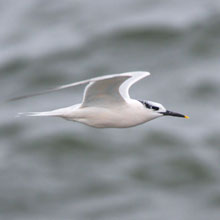
|
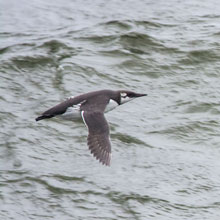
|
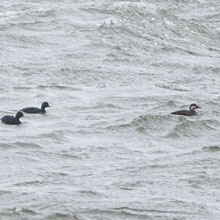
|
So our original expectations of
coming away with nothing more than a guid Scottish Breakfast turned out
to be over-pessimistic. The birds rose to the occasion and we were
there to capture the moments. We had to have our tea in the car though
as the rain made one last attempt to waste our day – no chance! John
had provided scones with real cream which disappeared far too quickly.
The Sun had the audacity to make an appearance as we drove home. But it
didn’t matter as it had been great fun without the sun – poetry!
Pictures of the week:
1st Cycle Herring Gull
|
Mediterranean Gull
|
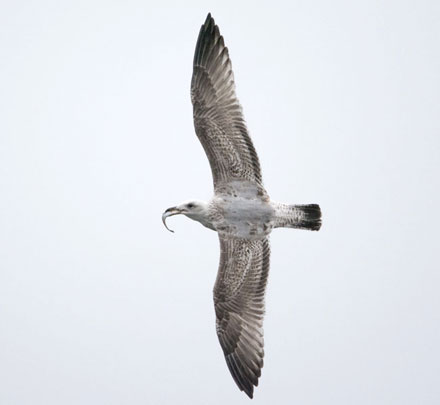
|
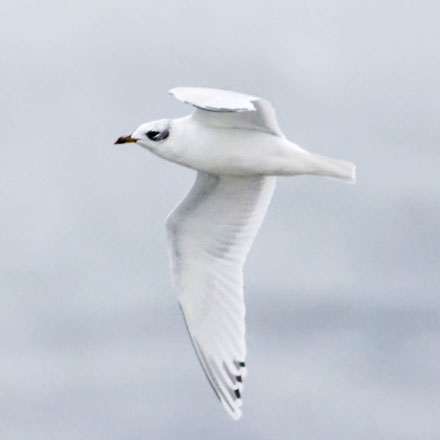
|
Eider
|
Sandwich Tern
|
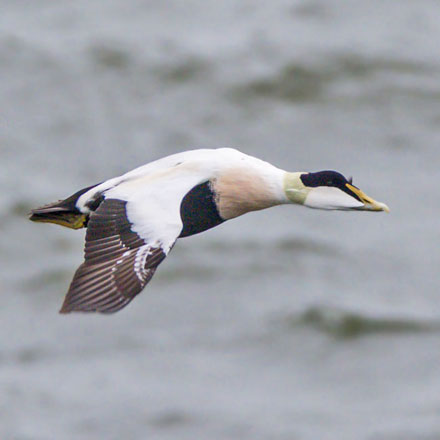
|
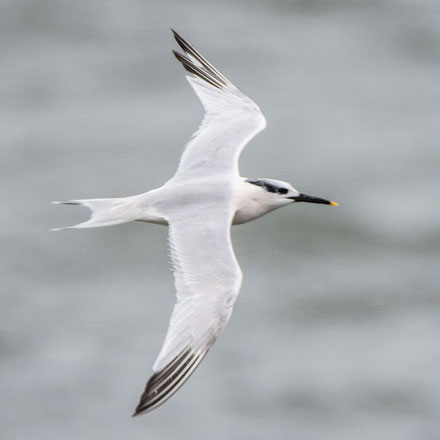
|
Back To Top
|

